There are a lot of benefits to moving fast in the game of Netrunner. On the runner side, if you’re quick to run out of the gates, that might mean free accesses before the corporation can afford to rez their ICE. If you can set up your rig in short order, than gives the corporation less time to score agendas behind their Ice Wall-Enigma server. As the corporation, if we’ve got strong burst economy and cheap end-the-run ICE, that means we may be able to score a few points quickly.
Perhaps most importantly, if the corporation can install and score agendas all in one turn, the runner won’t have a chance to access that agenda from a remote server. This is called Fast Advance, and it is perhaps the single most powerful corp tactic in competitive netrunner.
The Difference Between Rush and Fast Advance
There is some confusion about the terminology here, and to understand this article, you’re going to have to understand the difference.
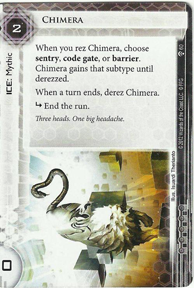
Rush decks are designed to set up a secure remote server very quickly and score as many agendas in that server as possible before the runner has the cards and credits necessary to get in. Of course, rush decks can’t expect to score a whole 7 points in this way very often, so they also incorporate other strategies to take advantage of a runner who is being pressured to get into your remote quickly, such as program destruction to catch the runner off guard, or flatline threats to slow them down.
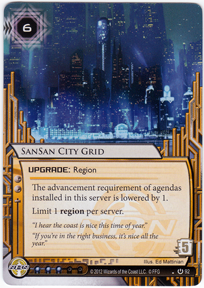
Fast Advance is a tactic defined by installing and scoring an agenda in the same turn. There are a number of ways to accomplish this. 2/1 Agendas like Breaking News and Hostile Takeover can be scored from your hand without any additional help. Biotic Labor gives us the extra click necessary to Fast Advance a Project Vitruvius. Astroscript Pilot Program’s agenda counter ability can be used without spending a click, which affords us the ability to score the next Astro from our hand. Because of how difficult it can be to stop a runner from setting up their rig in the long run, Fast Advance has become very popular in competitive corporation decks. It doesn’t matter much if the runner can get into all of your remote servers in the late game if you never have to put any agendas there.
I believe a large amount of confusion stems from the fact that many Rush decks incorporate Fast Advance. If you can rush a single Astroscript Pilot Program behind a Chimera, you might never have to score an agenda out of that remote again for the rest of the game. The two strategies complement each other nicely. It is often easy to rush a few points early, and score the rest of your points from your hand once the runner sets up well enough to get into your remote. However, just because your deck plays Fast Advance does not mean that it has to rush.
Why Give Up the Rush?
In this article, I am going to spotlight a few Fast Advance decks that sacrifice rushing power in favor of a stronger late game. But why would we want to skip the rush?
There are plenty of good reasons not to play a rush deck. Runners have a lot of tricks up their sleeves these days. Once you install an agenda in a remote server, the runner might Account Siphon you so that you can’t rez the ICE protecting your remote. They might have Inside Job or Test Run for Femme Fatale to give them the ability to get into your remote much faster than it appeared they were able to. They could even play a Self-Modifying Code and a Stimhack and steal your agenda despite starting their turn on $0 and no Icebreakers in play.
Beyond that, the ability to rush depends on you playing the right cards. If you play cheap EtR ICE and a lot of burst economy, rushing agendas out of the gate can be trivial. However, your NEXT Bronze and Ice Wall are going to look pretty silly once the runner installs a Yog.0 and a Corroder, and your Green Level Clearance isn’t going to generate a very significant amount of economy in the late game. The more you build your deck with the ability to rush, the worse your deck is going to be going deep.
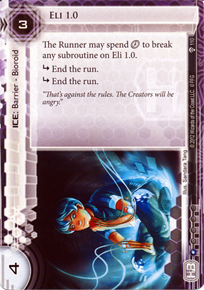
Ice like Eli 1.0 is super solid for a long game. Slap this on R&D and the runner is going to have to pay a significant amount of money to get in even once they install Corroder. This is hugely advantageous for use on central servers, because they need to be protected deep into the game. However, it’s a pretty miserable rush card. If you try to score an agenda behind an Eli 1.0, you run the risk that the runner runs it on click one and simply clicks through it.
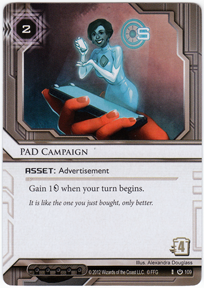
As innocuous as it may seem, PAD Campaign can be one of the strongest economy cards in the game. If you play a PAD campaign on turn one, it might very well net you $15 over the course of the game if the runner doesn’t trash it. This raw power comes at a cost: PAD campaign actually slows you down when you play it. It is going to take three turns just to recoup the cost of installing and rezzing it, hindering your ability to rush agendas, and because it can be trashed, you often want to play a piece of ICE to defend it, slowing you down further still.
Cards like these are the reason we might not want to rush. When we slow down our game, we get more economy options and the ability to incorporate ICE that is taxing to play against even once the runner inevitably sets up.
Slow Fast Advance
At its core, the idea behind Slow Fast Advance is to play cards that are expensive for the runner to deal with to create a disparity between your credits and theirs. Once you have secured an economic lead, you can stack taxing ICE on your centrals to bury the runner in expensive tolls and trash costs, and finally utilize cards like SanSan City Grid, Biotic Labor, and ASH that allow you to turn your extra credits into points without exposing your agendas to the runner. Meanwhile, your turn 2 Marked Accounts is making you a whole lot of money because of how long it has sat in play, and your remotes just get more and more expensive for the runner to get through while the cost of your Fast Advances never really goes up. In Magic terms, Slow Fast Advance decks are control decks whose win condition is to Fast Advance.
Let’s take a look at two HB Fast Advance decks to illustrate how the change of a single card can significantly slow your game down and what that means for the decks’ overall strategies:
2013 Petrie’s S2 – 1st Place Corp Deck
Haas-Bioroid: Engineering the Future
Agenda (11)
3x Accelerated Beta Test
1x Director Haas’ Pet Project
3x Efficiency Committee
1x Gila Hands Arcology
3x Project Vitruvius
Asset (6)
3x Adonis Campaign
3x Jackson Howard *
Upgrade (3)
3x SanSan City Grid ***
Operation (9)
3x Biotic Labor
3x Hedge Fund
3x Successful Demonstration
Barrier (8)
2x Eli 1.0
3x Ice Wall *
3x Wall of Static
Code Gate (3)
3x Enigma
Sentry (7)
3x Grim
1x Ichi 1.0
3x Rototurret
ICE (2)
2x Chimera
Plugged in Tour – Garden Grove, CA – 1st Place Corp Deck
Haas-Bioroid: Engineering the Future
Agenda (11)
3 Accelerated Beta Test
1 Director Haas’ Pet Project
3 Efficiency Committee
1 Gila Hands Arcology
3 Project Vitruvius
Asset (9)
3 Adonis Campaign
3 Jackson Howard *
3 Eve Campaign
Upgrade (3)
3 SanSan City Grid ***
Operation (6)
3 Biotic Labor
3 Hedge Fund
Barrier (9)
3 Bastion
3 Ice Wall *
3 Wall of Static
Code Gate(5)
2 Enigma
3 NEXT Bronze
Sentry (6)
3 Grim
3 Rototurret
These two decks have a lot in common. Both are HB Fast Advance decks using Biotic Labor and SanSan City Grid to score 3/2 agendas from their hand. However, there is one major difference between these two decks. One uses Successful Demonstration, and the other uses Eve Campaign.
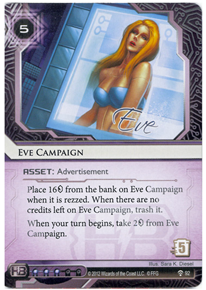
What does that mean for the playstyles of these two decks? Both of them are clearly capable of both rushing and Fast Advancing, but one of them has more staying power.
Eve Campaign is a ridiculously powerful economy card if you can get it to work for you. You’re netting 11 Credits for the single card and the click to play it. However, it’s a big trash target, and you often want to take the time to defend it. If you find yourself deciding on turn two or three whether to install an Eve Campaign or an agenda, you might decide it is more prudent to play the Eve Campaign and secure an economic lead rather than try to gain an early point lead and risk getting your agenda stolen.
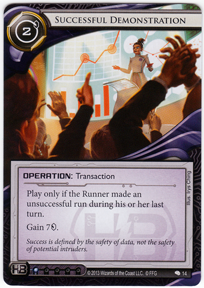
Successful Demonstration, on the other hand, rewards you for rushing you agendas. If you manage to pressure the runner by rushing agendas, they are more likely to run into your ICE without a way to break it and turn on Successful Demonstration. It might net you less than half the credits that Eve Campaign, but it’s going to get you those credits faster, despite the possibility of it being a dead draw late in the game.
Here are a couple of my own dedicated Slow fast Advance decks that have done well for me. These decks have little to no rushing power at all:
NBN Tax Man
NBN: Making News
Agenda (11)
3 AstroScript Pilot Program
2 Breaking News
3 Character Assassination
3 Project Beale
Asset (8)
3 Jackson Howard
3 Marked Accounts
2 PAD Campaign
Upgrade (6)
2 Ash 2X3ZB9CY **
1 Bernice Mai
3 SanSan City Grid
Operation (6)
3 Hedge Fund
3 Sweeps Week
Barrier (5)
3 Eli 1.0 ***
2 Wraparound
Code Gate (7)
3 Pop-up Window
2 Tollbooth
2 Viper **
Sentry (6)
3 Caduceus **
3 Draco
I’ve been running some variant of this deck since I started playing the game. On it’s face, it looks like a pretty uneventful, no frills deck. It doesn’t splash Biotic Labor and it doesn’t play Midseason-Psychographics combo. It doesn’t play any tag punishment whatsoever. Instead, it plays a couple of boring underappreciated economy cards in Marked Accounts and PAD campaign and a pair of Ashes to make running taxing servers a whole lot more brutal. I piloted a variation of this deck to a win at my local store champs this past weekend, dropping 2 games in 8 rounds.
The way that drip economy changes the NBN game plan can not be understated. When you play all of this taxing ICE like Caduceus, Eli, and Tollbooth, you have a pretty amazing long game even against decks like Katman that have super-efficient rigs, and at 15 cards with trash cost of 3 or more, the runner is going to have to make tough choices about whether to trash your SanSans, your Marked Accounts, or to ignore both and pay to get into R&D. If you create a sufficiently expensive remote server, you can start to install assets, agendas, and upgrades and just dare the runner to burn a whole turn checking to make sure whether your Jackson Howard isn’t an Astroscript. Furthermore, Breaking News, Character Assassination, Draco, and Bernice help to ensure any runner relying on high-investment resources like Kati Jones and Professional Contacts for economy are going to face an uphill battle to keep those cards on the table.
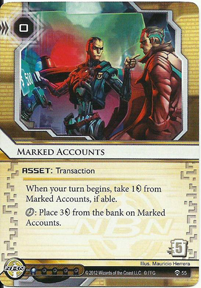
Marked Accounts and PAD Campaign are absolutely central to this deck’s strategy. It’s expensive to build ICE towers, and it’s expensive to Fast Advance. If you’re going to be doing these things in a long game, you’re going to need powerful economy cards to set you up. The high trash costs mean that if the runner wants to keep you off your economy, they will have to hurt their own economy early on, potentially creating scoring windows, or at the very least, slowing them down significantly enough to give you time to get some more drips online.
Cerebral Gift
Cerebral Imaging: Infinite Frontiers
Agenda (10)
3 Accelerated Beta Test
3 Corporate War
1 Efficiency Committee
3 Project Vitruvius
Asset (3)
3 Jackson Howard *
Operation (20)
3 Archived Memories
3 Biotic Labor
3 Blue Level Clearance
2 Celebrity Gift ***
3 Green Level Clearance
3 Hedge Fund
3 Restructure
Barrier (3)
3 Eli 1.0
Code Gate (4)
3 Viktor 2.0
1 Viper
Sentry (9)
3 Caduceus **
3 Ichi 1.0
3 Rototurret
This deck takes slow to the extreme. Your goal is to never set up a remote server, and to win the game by generating a huge amount of credits while drawing your entire deck, closing out the game by playing Biotic Labor 4 times. Often, you end up drawing very close to your entire deck in order to accomplish this.
You come out of the gates with the goal of icing up HQ and R&D. Once these two servers have some taxing ICE rezzed on them, you can start drawing cards and playing economy operations to increase your maximum hand size. Because you have such high-impact economy operations along with Jackson Howard and Archived Memories to recur them, it’s not difficult to accumulate 15 cards in your hand with a few Hedge Funds to spare.
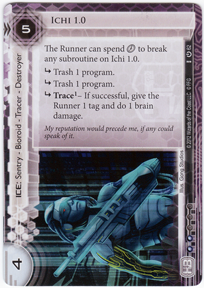
The ICE in this deck is purely taxing. Every single piece has 2 or more subroutines, and that generally means that the runner is going to have to pay in one way or another to get past them. Only having two servers to protect in most cases means that you have more money to draw cards and snowball advantage with economy operations while the runner takes blind, expensive stabs at your centrals.
The agenda spread says a lot about how this deck plays. Why 3 Corporate War and not 3 Efficiency Committee? Well, the short answer is that it doesn’t actually matter. You hardly every actually score those 4//2s. If you don’t want to score them, why wouldn’t you play a couple of Profiteerings instead of the 4th 4/2? If you did, you’d be giving the runner more agendas to steal, you’d be shorting yourself one non-agenda deck slot, and by the time you want to score a Profiteering, you’d probably be rich enough to Biotic out the win in the next few turns anyway. Most importantly, because you’re a slow Fast Advance deck, you aren’t in any hurry to score. If it’s turn 7 and you still haven’t found a 3-advancement agenda, it makes very little difference, because by the time you want to score, you will have seen over half of your deck and are bound to have something available.
One interesting consequence of drawing your whole deck is that you find yourself in situations where the runner cannot possibly win the game even if they steal every agenda in R&D. This allows you to focus entirely on defending HQ with taxing ICE, and makes running Beta Tests appealing even when you don’t have a Jackson Howard ready to resuce agendas from the bin. When you only have one server to defend, and it costs the runner upwards of 10 credits to get in, that really is the ultimate way to create the kind of credit disparity that slow Fast Advance decks need to start scoring.
Sit Down and Stay a While
In the end, slow decks can afford you a lot of advantages. You can reduce variance by seeing more cards, (there’s bound to be a SanSan and an Astroscript in there somewhere!), you have more time to potentially outplay your opponent, and you’re never totally out of a game just because the runner is fully set up. Do yourself a favor and put away the Chimeras for a second, pick up a Slow Fast Advance deck, and pour yourself a cup of coffee. It’s time to take back the late game from the runners. We’re in it for the long haul.
If you want to see me slog it out with some slow decks, check out my YouTube channel or my Twitch stream!
https://www.youtube.com/user/DargenioDan
http://www.twitch.tv/mediohxcore
Dan D’Argenio
Mediohxcore on the Forums
Calc3 on Reddit
DanDargenio@gmail.com




